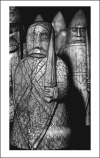 |
Scottish Annotated Games |
Last updated 21 March 2002


|
Fabri, F - Kilgour, D A [C02]
XI Olympiad Final, 1995
[Notes by David Kilgour]
1.e4
e6
2.d4
d5
3.e5
[This is the advance variation, which results in a difficult game for Black as he is constrained
by the wedge of white pawns on b2, c3, d4 and e5, but these pawns allow Black strong counterplay by
c5, b5-b4, and f6. The main idea for White is to tie Black up and then start a kingside attack as
Black often castles there. Even if Black castles queenside, he will find that White can open that side
of the board by playing b4, a4, etc., or perhaps c4 in some variations. Black has to plan how to play
after 3.e5 with the following choices available:
a. try to exchange white-squared bishops as the black bishop will not have much scope for some time
b. knights will be god pieces for attacking the white centre in this closed position, so f5 and c6 will
be good positions for black knights
c. play c5 to attack the base of the pawn chain and develop the black queen to b6 and knight to c6 to
build up pressure on the d-pawn
d. play c5 and rook to the c-file and play cxd-pawn with the plan of control of the open file
e. play f6 and try to undermine the white centre - this will often result in either the f- or g-file
being opened, giving Black attacking opportunities.]
3...c5
4.Nf3
Nc6
[4... cxd4 is fine, but I prefer the long-term closed lines as, after cxd4, the position is opened
and the e-pawn could become weak, but White gets goodattacking chances.]
5.c3
Qb6
6.a3
[Black's last move stops the white black-squared bishop moving and adds to the pressure on the d4
square. If 6.b3 cxd4 7.cxd4 Bb4+ or 6.dxc5 Bxc5 and Black is active. The main alternative to 6.a3 is
6.Be2 and Black could try the plan with the knights explained above.]
6...c4
[I played Fabri in the SCCA Magazine Tourney, and tried a plan involving a5, cxd4 and f6 to clear
the white centre, but White managed to get a good kingside attack and I lost in 32 moves. White has the
idea of queenside expansion involving b4 and a4, so c4 stops this idea for the moment.]
7.Nbd2
Na5
8.g3
Bd7
9.h4
[9.Bh3 or 9.Bg2 seem better, but the idea behind 9.h4 is to gain space on the kingside by h5-h6
and Nh2-g4.]
9...0-0-0
10.Bh3
f5
[With the idea of playing Nh6-f7, protecting d6 and threatening to further undermine e5 by g5.]
11.exf6
gxf6
12.0-0
Ne7
[Black is planning a kingside attack by opening the centre with e5, but first he must take control
of the g-file. Black will exchange the white-squared bishops after e5, which will help with the attack
on the kingside, but it does also weaken the black king.]
13.Re1
Rg8
14.Nh2
[Perhaps this is part of a long-term plan, but it is difficult to see it in the game, as e5 opens
the position and the knight is left at the edge of the board with no place to go. I was rather troubled
at this point, as I wished to play Bg7 before e5, but e5 is now quite good as it will open up the centre
to Black's advantage as his pieces are better developed.]
14...e5
15.Bxd7+
Rxd7
16.Qh5
[Perhaps 16.Nhf3 was better here.]
16...exd4
17.Kf1
[There were various threats due to the black queen being on the a7-g1 diagonal, which 17.Kf1 stops.
White really has major difficulties in developing his queenside pieces. Black has some advantage,
especially as his plan has worked quite well, and he controls the centre. White will get some queenside
play if Black accepts the pawn, and Black should strengthen the centre with Nac6.]
17...dxc3?
18.bxc3
d4
19.Rb1
Qa6
20.Qxh7
dxc3
21.Ndf3
Nac6
[The white king is still in trouble, but it is amazing that the pair of black-squared bishops have
still not moved after 21 moves.]
22.Re3
f5
23.Ne1
Rd1
24.Kg2
Qa4
25.Nhf3
c2
26.Rb4
Qa6
27.Rc3
Nxb4
0-1
[The black-squared bishops never moved in this game, while the knights played a major part in the
destruction of the white centre, which is often the case in closed variations of the French.]
| Click to return to index page Games Index |
Click to download in PGN format Fabri v Kilgour |
Generated with ChessBase 8.0 |





















